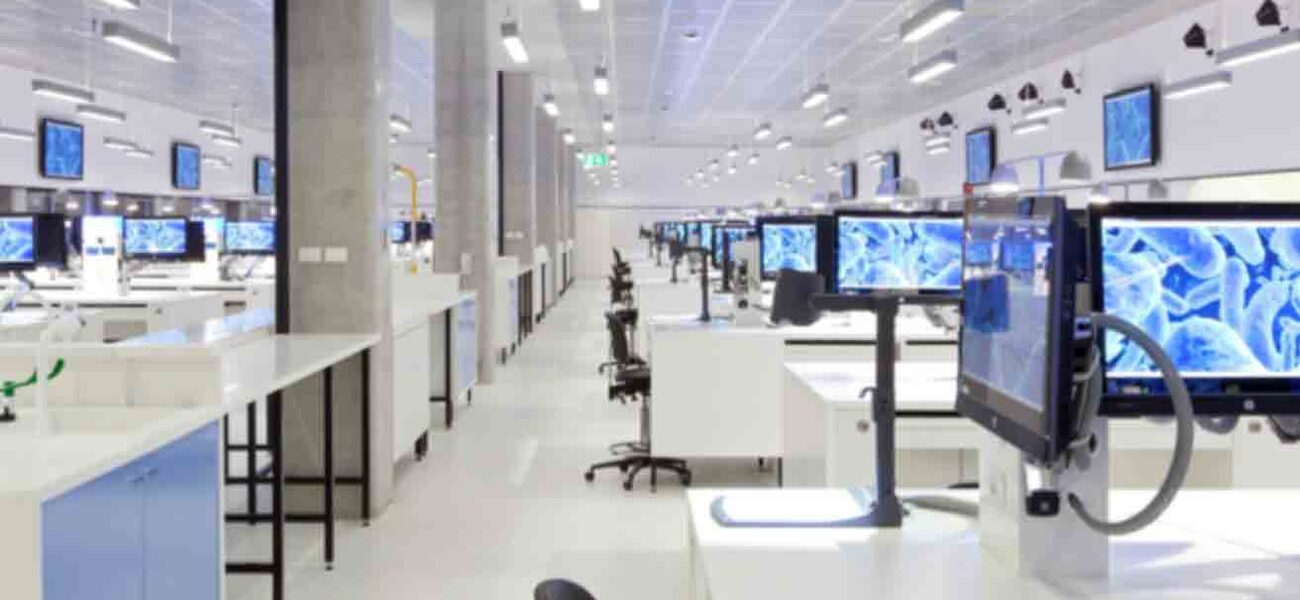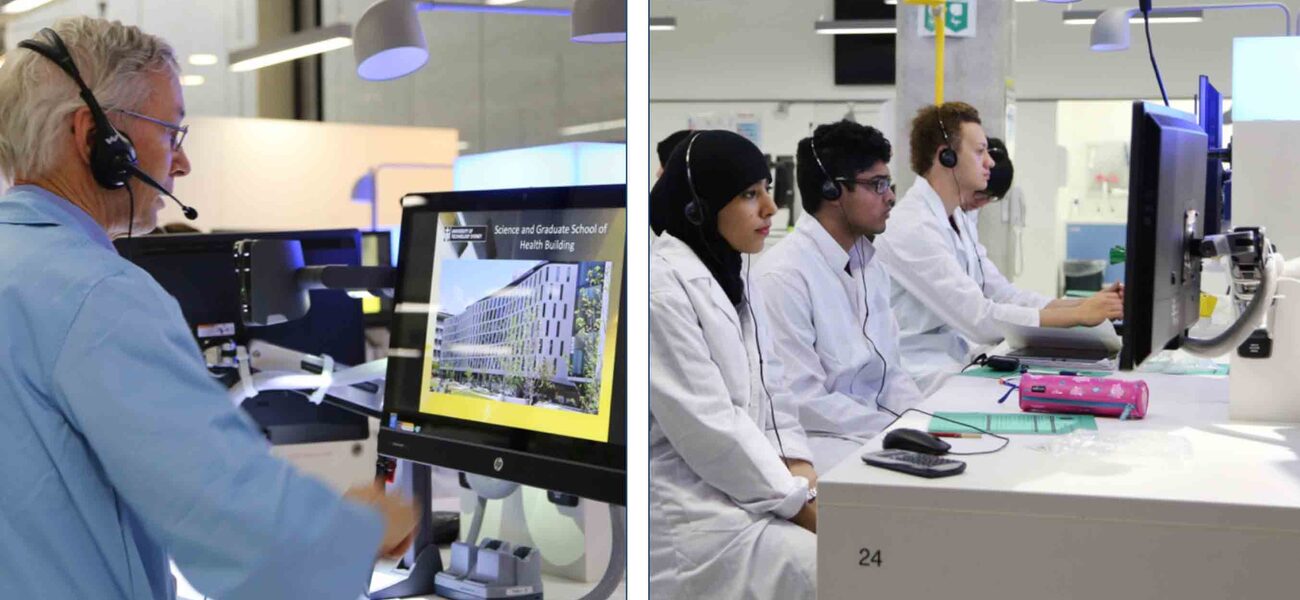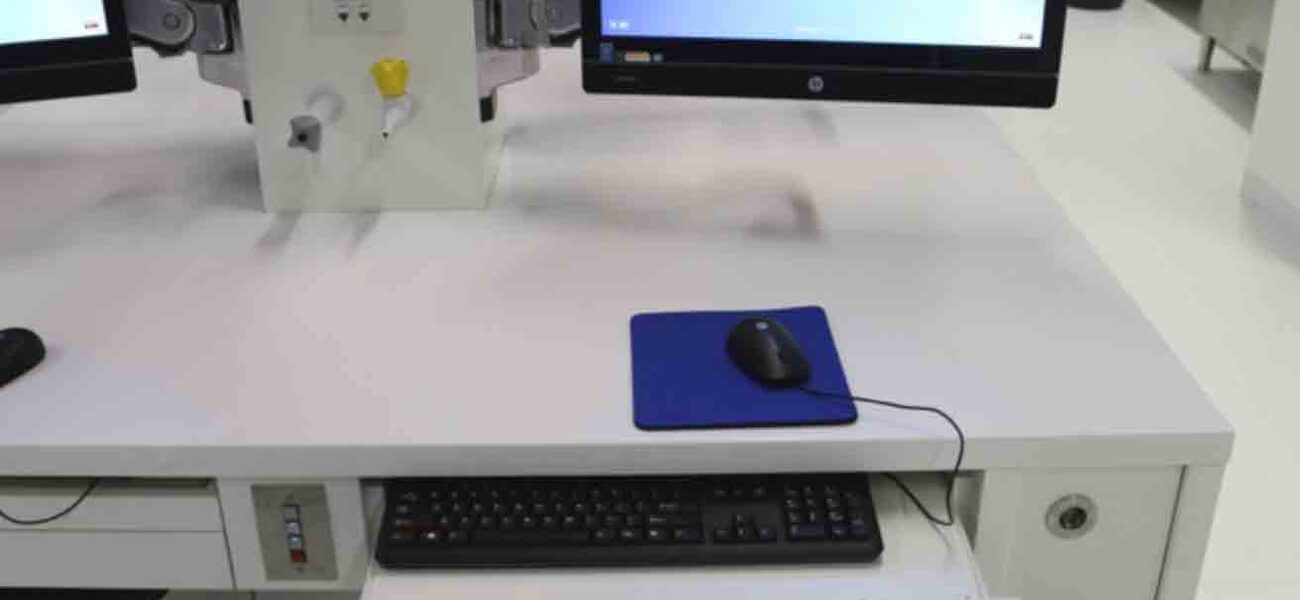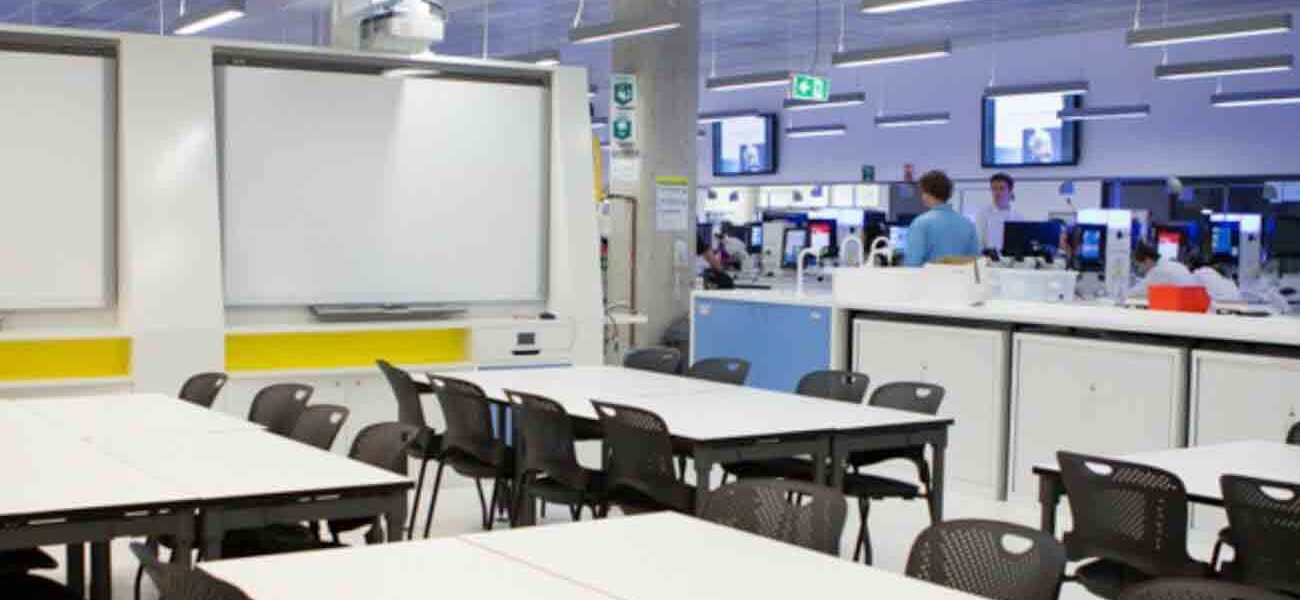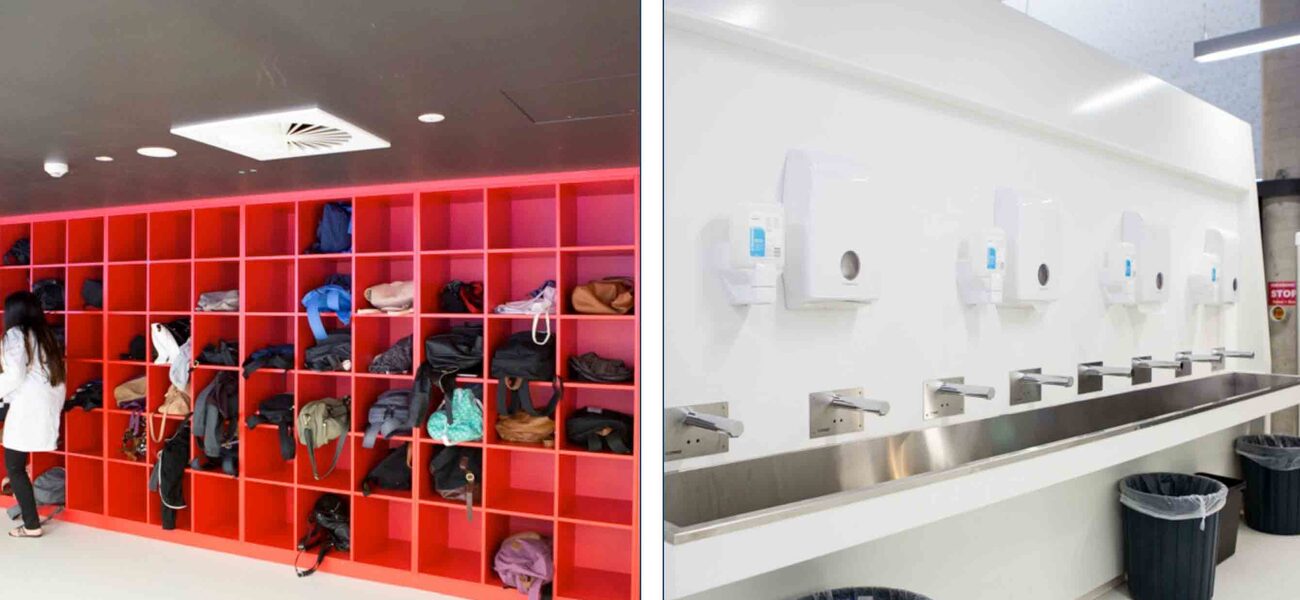The “Super Lab,” opened in 2015 at the University of Technology Sydney (UTS), in Sydney, Australia, can host more than 200 students in up to five different lab classes simultaneously. With several sessions held each day, the Super Lab sees 2,500 to 3,000 student entries per week, a figure that, for a single lab space, is “rather horrifying to academics at first face value,” says Bill Booth, laboratory operations manager at UTS. “Academics generally like to teach in small dedicated spaces.” But despite this, says Booth, the Super Lab is working well, and it may even be an optimal environment for introductory science instruction in the 21st century.
The Super Lab was UTS’s answer to a burgeoning undergraduate science enrollment. In 2014, the university taught science to undergraduates in a suite of 15 generic 1,937-sf teaching labs housing classes of 40 students each. But according to enrollment projections, by 2020 the university would need five more of these teaching labs, or 9,687 sf of additional teaching lab space.
Building the Super Lab instead of five smaller labs allowed UTS to cut the 9,687 sf figure to 8,611 sf. And evidence is mounting that the efficiency gains are educational as well as spatial: Students are learning better in the new environment. But to create a functional super lab requires more than just a big room.
Lessons from London
UTS’s planning team visited the world’s first open-plan super lab at London Metropolitan University to learn what works, and what doesn’t work, in a large-scale, open-plan teaching lab. They found a lot to like at the London facility, which accommodates 280 students in biosciences programs ranging from first-year chemistry and applied biology to high-level project work.
Booth was particularly impressed that high-level subjects were taught in the London facility. “They had very high mobility,” says Booth, referring to the need for students to move physically from one part of the lab to another, for example to use a fume hood. “It is rather a staggering thing to think that so many students are in a lab with mobility that high.”
What didn’t work in the London Met super lab were the microbiology classes. “That created contamination issues,” says Booth. “And structurally, there was a problem with the air handling in alcoves that contained biosafety and fume cabinets.”
The visit to the London facility made two things clear to the UTS team: A super lab can function as well as a traditional smaller lab, and the best use of a super lab at UTS would be to host lower-level science courses. This had major design ramifications:
- Simplification. Introductory science experiments are cleaner, take up less space, and use simpler equipment. The Super Lab should capitalize on any economies of scale enabled by simplification and consolidation.
- Full exploitation of digital resources. A wealth of educational software exists to teach introductory chemistry and biology, and computers have become adept at controlling lab equipment and capturing and processing empirical data. The Super Lab should fully integrate digital STEM teaching tools.
- Capturing the attention of Generation Z. Today’s students have shorter attention spans and learn differently than students in decades past. The Super Lab should integrate multimedia while minimizing environmental distractions.
- STEM recruitment. The Super Lab should present a visually striking appearance and a seamless user experience to make STEM careers more appealing to beginning science students.
Efficiency
“A key advantage of building one Super Lab instead of five smaller labs is that it eliminates separation walls and corridors,” says Booth. “Every wall means loss of lab bench space, since there are bench-to-wall thoroughfare and egress distances to apply to either side of the wall.”
The Super Lab also improves utilization by assigning classes to benches instead of entire laboratories. A lab course with 90 students, for example, would require three traditional 40-student labs, but 30 of those lab seats would remain unoccupied. The same class in the Super Lab would be assigned to 12 of the lab’s 26 eight-student benches, leaving only six seats empty.
The pooling of space enables sharing of core scientific equipment, and consolidation of fume hoods into a single bay. Equipment is stored in islands running through the center of the lab space. Classes requiring access to fume hoods are assigned the benches closest to those resources.
The Super Lab also accommodates variety in course duration, and start and end times. A display screen in the lab’s entry foyer directs incoming students to their class’s assigned benches in much the same way that air travelers are directed to airport gates.
But you can’t learn science in an airport, and the Super Lab’s efficiency gains would be pointless without robust noise control—acoustic flooring and ceiling panels that make it “surprisingly quiet, much quieter than our normal 40-place labs,” says Booth. “The low background noise means that multiple classes can all operate without their noise crossing over to one another.” Another factor keeping the noise down is the headsets through which instructors communicate with students. “The instructor can speak in a normal tone of voice and be easily heard by a 10-bench class,” says Booth.
Teaching
The acoustic dampening and the headsets do more than just cut noise; they also improve the efficiency of the STEM teaching by screening out distracting sensory input and focusing students’ attention on the teacher’s voice, and on the information on the computer screen in front of them.
Benchtop computers, one per student, are equipped with two kinds of software: lab software to control lab instruments and automate data collection and analysis, and educational software to complement in-class exercises. Students also benefit from online learning resources and report-writing and data storage applications.
Lab instructors teach from “demonstrator stations.” One station is provided for every two benches. The resulting student-teacher ratio of 16 to 1 provides “good supervision, line of sight, and intimate connection with students,” says Booth. Instructors can also display video and overhead document information to students via wall-mounted LCD screens.
Next to each computer is a bollard that both delivers power, data, natural gas, and vacuum services and, in an innovation borrowed from the London Met super lab, serves as a key interface between instructor and student. Lights on top of the bollard communicate various conditions. A blue light alerts students to put on their headphones to hear the instructor; students needing the instructor’s attention can press a button to turn on an orange light or, if their need is urgent, a red light.
The bollard also contains a flexible microphone for students to speak to the teacher and to the class. (The student headsets lack microphones.) So far, however, these microphones haven’t been used much; the student-teacher ratio is low enough that face-to-face conversations have been viable. “The bollard microphone will be more useful if there is a larger class controlled from one instructor station,” says Booth.
The Super Lab is best suited for delivering courses that enroll large numbers; use small, common lab instruments and standard glassware; and inspire innovative applications of information technology. So far, UTS has used the Super Lab for chemistry, biology, cell biology/biochemistry, physics, physiology, and pharmacy compounding.
The Super Lab is less appropriate for:
- Courses in which students use large, immobile instruments, such as gas chromatographs or mass spectrometers
- Courses for which learning software is not well developed
- Courses in which demonstration materials, such as environmental specimens, occupy large areas of the bench
- Courses that require students to use resources in multiple lab locations (In the Super Lab, this would cause one class to enter the physical space of another.)
One final consideration unique to UTS’s facility is the avoidance of courses that involve staining of tissue samples or other materials, because the Corian benchtops have a pristine, modern look that enhances the lab’s visual appeal and attracts potential STEM majors. “We intend to keep the new, clean look of the lab for as long as possible,” says Booth. The visual environment is further enhanced by a light well that brings daylight into the subterranean space.
Lab designers confronting the super lab concept for the first time often suspect that such facilities are “student factories” incapable of delivering the small-group and peer learning emphasized in contemporary STEM pedagogies. But the suspected weaknesses of the super lab environment are turning out to be strengths, says Booth. The low student-teacher ratio and acoustic control seem to be fostering intimacy in class groups. The consolidation of lab space made it possible to provide, at the lab’s edge, sizable breakout spaces for roundtable discussion, a feature that is absent in conventional lab environments. And the presence of different classes in the same room is exciting students’ interest in science, as they catch glimpses of other classes’ experiments on neighboring benches.
The Super Lab also seems to be improving learning outcomes. Failure rates in chemistry courses taught in the Super Lab during its first year were the lowest on record. But, as might be expected, some instructors have been slower to warm. “Most of the instructors have adapted to the lab and run their class exercises smoothly,” says Booth, “but some—often long-term academics—have found it difficult to adapt to the multi-class environment and to audiovisual communication. They are simply too used to having their own individual labs and not being encumbered by microphones and program software.” Fortunately, says Booth, there are still plenty of traditional lab spaces at UTS for those instructors to teach in.
By Deborah Kreuze
For a Project Profile on the building containing the Super Lab, click here.
